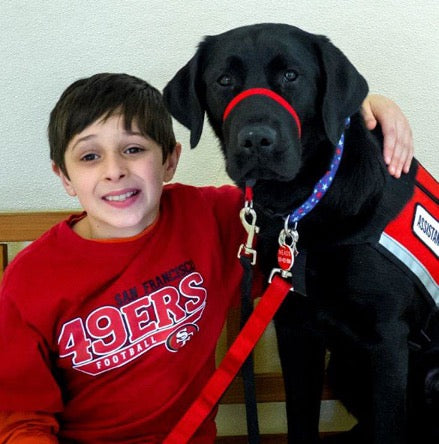By Kristin Hartness, Canines for Disabled Kids
Chances are the people aren't going to stop you while crossing the street to grill you about your service dog. However, all users of legal service dogs must be able to answer these questions: Is the dog required because of a disability? And what skill or skills has the dog been trained to do that directly relate to the individual's disability?

Service dogs are defined by federal law—the Americans with Disabilities Act—as dogs that are individually trained to do work or perform task for people with disabilities. The law goes on to state that "comfort and emotional support do not qualify as service." What does this mean? It means that this is the most customized, intimate tool you will ever use to gain independence over your disability.
I am most often asked, "Do I (or my child) qualify for a service dog?" This is followed quickly by, "How do I get the right service dog for me?" The first question is easier to answer and often I answer this while standing in line at the airport, grocery checkout or movie theatre. The second takes more time. To get the perfect service dog, you need to work with the perfect trainer. To select the trainer/training program which best suits your needs, first you must understand your needs and if it is possible for a dog to be trained with a skill to help those needs. Dogs for protection or companionship are not service dogs. (Companionship is a result of working with a living tool and not a trained skill.)
The most familiar of the service dogs are known as Guide Dogs. Their ability to lead people who are blind through day-to-day activities safely has been featured in everything from children's books to news articles to TV. However, Guide Dogs are not alone in being valuable tools to many people living with disabilities.
The services performed by these clever canines can also include alerting hearing impaired individuals to sounds such as fire alarms, alerting an individual with diabetes to blood sugar highs and lows or interrupting repetitive, disruptive behaviors of someone with PTSD. My service dog provides stability as I walk and fetches dropped items. These trained skills prevent falls and increase my ability to live and work independently in today's world. To list the full range of skills that have been trained to help people living with a variety of disabilities, would take far more space than I have been given for this article! More trained skills are being developed all the time.

Dogs are incredibly versatile animals. They want to work with people. They need to have relationships with people. We want to be with them. These characteristics make them the perfect tool to bring more independence to individuals with disabilities across the United States. Training a dog to be the service dog you need takes a lot of patience, skill and time. With 200 or more training programs in the USA, the search can be confusing. It is important to look at programs which train the skills you need, work with your geographic locations (most serve small parts of the country) and your age (most have age restrictions).
- Start by looking at the website. What do they offer; how much do they tell you; how easy is it to contact them; are they part of a federation such as Assistance Dogs International or International Guide Dog Federation and why or why not; are they for profit or not-for-profit as this will affect your ability to fundraise the training costs; how much will you need to raise to cover part or all of the training costs which average $25,000?
- Select your top 3 programs.
- Contact them by email or phone with any questions. (This will give you a chance to see how they respond to you.)
- Apply to your top choice.

Private or self-training is legal but not the right choice for most people. You must have the time and financial resources to invest in the dog along with the emotional ability to walk away from a dog you may have invested 2 years in because it cannot do the skills needed while keeping appropriate public behavior in all environments.
Failure rates are 50% and higher with both private and program dogs. Resources you may use to find training programs include:
- Search engines, though this will generate an unorganized and mixed list of training programs and other related sites.
- Federations can provide you a list of member programs. Some are grouped by work style which can help in narrowing your search.
- Contact Canines for Disabled Kids. We will discuss your situation, your desires and provide you with a list of possibilities and tools to evaluate your options.
The most important thing is to take the time to find the perfect, legal service dog for you.
For more on Canines for Disabled Kids, visit www.caninesfordisabledkids.org.

